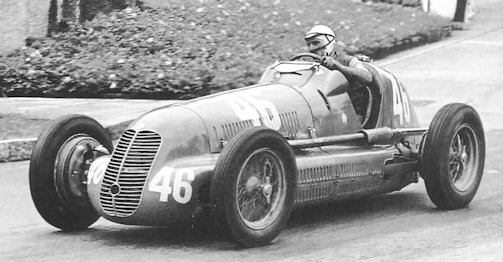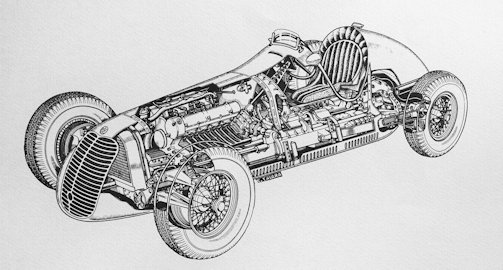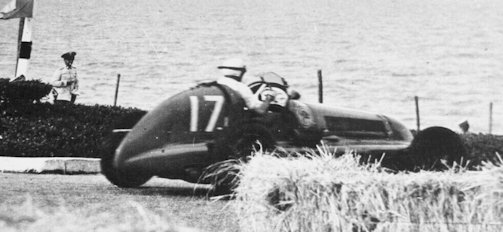Maserati 4CL Grand Prix Car
 | |
Manufacturer | Maserati |
Class | Race Car |
Seats | Single |
Engine | 4-cylinders Capacity 1,496 c.c. |
Production | from 1939 to 1948 |
Length | 3850 mm |
Width | 1400 mm |
Height | 1000 mm |
Mass | 630 k g |
The Maserati 4CL, were single-seat competition race cars built by Maserati from 1939 to 1948 pre and post war.
History
The Maserati 4CL was often referred to as the "16-valve" Maserati, the 4CL was first built in 1939 for voiturette racing. It has a four-cylinder twin overhead camshaft engine of "square" cylinder dimensions (78 mm. bore and 78 mm. stroke), giving a capacity of 1,489 c.c. Output was claimed to be 220 b.h.p. at approximately 8,000 r.p.m.
This gave the car outstanding acceleration, and although the 4CL could not beat the Type 158 Alfa Romeos, it proved the mainstay of Grand Prix racing in the early post-war years before the appearance in 1948 of a newer Maserati, the 4CLT. The 4CL single Roots-type supercharger, dry- sump lubrication, a four-speed gearbox, independent
front suspension by wishbones and torsion bars, a live rear axle sprung by quarter-elliptic springs, and hydraulic brakes.
Maserati found that 1.5-litre voiturette racing was a much more sensible proposition for a factory such as theirs during the thirties. National prestige which led Alfa Romeo once again to react to the stimulus and turn to Maserati brothers' building a new voiturette themselves. Since at the time Italians could not play in the league as the German teams.
Maserati introduced their six-cylinder 6C model for voiturette racing in 1936, replacing the formal four and eight-cylinder models. In general design it followed on from the eight-Cylinders but the twin-overhead-camshaft 1493 cc power unit was good for 155 bhp at a smooth 6200 rpm. From 1936 to 1938 the Maserati 6C was very competitive with the similarly six-cylinder ERA cars and in Italian national events and most others around Europe it numerically saturated the field. It was in response to the success and prestige achieved by these 6Cs that Alfa Romeo weighed in with their straight-eight Tipo 158 voiturette in 1938; to combat its threat the ever-cheerful and willing Maserati brothers produced in turn their 4C. The 4CL project was by Ernesto Maserati with Luigi Villoresi at the helm, using the 6C chassis to carry 1088 and 1496cc twin-overhead-camshaft engines.
The Alfetta proved to be streets ahead, and in 1939 the 4CL was released with four valves per cylinder. As the 'Sixteen-valve' Maserati this model became famous, as did its 'square' dimensions of 78mm x 78mm to give 1489 cc, and its supercharged power output of 220 bhp. However, while the Maserati won everywhere not attended by the Alfetta team, it could not combat the 158s on equal terms. But postwar, Maserati would be back, with modified versions of this late-thirties voiturette.

Performance: Some of these cars have been used with two stage supercharging, giving about 225 B.H.P.
- 210-220 b.h.p.
- Piston speed: 3,600 ft. per min. B.M.E.P.: 278 lb. per sq. in. 258 h.p. per ton (laden), 365 per ton (unladen).
The 4CL was introduced at the beginning of the 1939 season. It ran in the voiturette class of the international motoring Grand Prix. Although the competitions ended during the Second World War, the 4CL was one of the models that imposed itself on the resumption of the races in the late forties. Experiments with a two-stage volumetric compressor and a tubular frame eventually led to the introduction in 1948 of the revised model 4CLT.
In the second half of the thirties the rapid development of the competitiveness of the voiturette class, the introduction of the Alfa Romeo 158 and of the ERA models led Maserati to design a new in-line four-cylinder engine. This engine delivered 30-50 bhp more than the previous six-cylinder in line thanks to the increase in the number of valves (now four per cylinder), the use of a more powerful volumetric compressor and a small increase in the compression ratio. The displacement it was 1491 cm³. According to Maserati tradition, the engine was mounted on a chassis of a previous model, in this case of the Maserati 6CM. Although it had an almost identical wheelbase to the Maserati 6CM, the 4CL had a wider track of 5 cm, and was lowered thanks to the repositioning of the shock absorber spring connections. To wind this traditional type frame there was a low and curvilinear car body, consisting of light alloy panels and always built at Maserati. The Trident House also manufactured an aerodynamic version of the 4CL. The frame had a conventional architecture, with two box section spars running along the entire length of the car body. However, the 4CL project used much more aluminium alloy components than in the previous model. The change was a four-speed manual. The front suspensions were independent with a torsion bar. The rear ones had a crossbow and a rigid axle.
The Engine development continued in response to the introduction by Alfa Romeo of supercharged engines with a two-stage compressor. However, this led to highlighting the weakness of the chassis design. As an attempt to increase its torsional rigidity, Maserati began experimenting with tubular frames. These tests were initially applied to 4CL in 1947, and led to the introduction of 4CLT in 1948.
Johnny Wakefield won three races in 1939 at Naples, Picardy and Albi with a 4CL, and the same car was raced after the war by Reg Parnell, who won the 1947 Jersey Road Race with it. Other 4CL victories in the same period included the Nice, Marseilles, St Cloud, Albi and Penya Rhin Grands Prix of 1946, the Argentine, Pau, Frontieres, Nice, Nimes, Marne and Lausanne G.Ps. of 1947, and the Pau and Zandvoort G.Ps. of 1948. Villoresi, Chiron, Parnell, Ascari, Farina and Bira were among the famous drivers of this mode
The aerodynamic version of the 4CL won pole position at the Tripoli Grand Prix in 1939, ahead of the Mercedes W165. During the race two of the three cars taking part in the race withdrew due to engine problems, leaving the victory at Mercedes-Benz. The victory came however two Grand Prix after, more precisely to the Grand Prix of Naples with the private driver John Peter Wakefield. In the remaining races of 1939reserved for the "voiturette" category, Wakefield took two more victories, and the official car two others, before the outbreak of the Second World War interrupted international competitions. Luigi Villoresi brought the 4CL to victory in the 1940 edition of the Targa Florio. In this edition of the race there was however the limitation only to the cars coming from the Axis Powers.
At the resumption of competitions in 1946, Luigi Villoresi immediately returned to victory, winning the first race that followed the cessation of hostilities, the Nice Grand Prix. Even Tazio Nuvolari and Giorgio Pelassa won with the 4CL, but the dominator of the season was Raymond Sommer, also with a 4CL. The most successful season was the one held in 1947 where the Maserati riders won 10 races, despite the fact that the Alfa Romeo fielded the revised 158 and the new Type 308.
After the 4CL was replaced by the new 4CLT, many specimens of the older car were sold to private individuals. It was thanks to the popularity achieved by 4CL with private pilots, several of these were able to compete at a high level until the advent of the first Formula 1 championship in 1950.

Rating
Technical
-
Maserati 4CL Technical details and specifications (1939-1948)
ENGINE:
Type 4-cylinders
Bore and stroke: bore 78 mm. , stroke 78 mm
Capacity 1,496 c.c.
Twin overhead camshafts.
Single Roots-type supercharger.
Four valves per cylinder (8 exhaust ports).
Piston area : 29.6 sq. ins.
Dry-sump lubricationCHASSIS:
channel-section frame.SUSPENSION:
independent front suspension by parallel torsion bars and wishbones.
Rigid rear suspension by quarter-elliptic leaf springs (splayed outwards towards the rear) and radius arms.TRANSMISSION DRIVE LINE:
Four-speed gearbox.
Normal transmission. Oil tank beneath the driving seat forming a frame cross-bracing.BRAKES:
Hydraulic brakes.DIMENSIONS AND WEIGHT:
Weight (empty): 12b cwt.
Fuel tank holds about 35 gals. (range about 115 miles).© Motor car History




